Related Research Articles

John Milton was an English poet, polemicist, and civil servant. His 1667 epic poem Paradise Lost, written in blank verse and including twelve books, was written in a time of immense religious flux and political upheaval. It addressed the fall of man, including the temptation of Adam and Eve by the fallen angel Satan and God's expulsion of them from the Garden of Eden. Paradise Lost elevated Milton's reputation as one of history's greatest poets. He also served as a civil servant for the Commonwealth of England under its Council of State and later under Oliver Cromwell.
Old English literature refers to poetry and prose written in Old English in early medieval England, from the 7th century to the decades after the Norman Conquest of 1066, a period often termed Anglo-Saxon England. The 7th-century work Cædmon's Hymn is often considered as the oldest surviving poem in English, as it appears in an 8th-century copy of Bede's text, the Ecclesiastical History of the English People. Poetry written in the mid 12th century represents some of the latest post-Norman examples of Old English. Adherence to the grammatical rules of Old English is largely inconsistent in 12th-century work, and by the 13th century the grammar and syntax of Old English had almost completely deteriorated, giving way to the much larger Middle English corpus of literature.

Benjamin Jonson was an English playwright and poet. Jonson's artistry exerted a lasting influence on English poetry and stage comedy. He popularised the comedy of humours; he is best known for the satirical plays Every Man in His Humour (1598), Volpone, or The Fox, The Alchemist (1610) and Bartholomew Fair (1614) and for his lyric and epigrammatic poetry. He is regarded as "the second most important English dramatist, after William Shakespeare, during the reign of James I."

The cavalier poets was a school of English poets of the 17th century, that came from the classes that supported King Charles I during the English Civil War (1642–1651). Charles, a connoisseur of the fine arts, supported poets who created the art he craved. These poets in turn grouped themselves with the King and his service, thus becoming Cavalier Poets.

Sir William Davenant, also spelled D'Avenant, was an English poet and playwright. Along with Thomas Killigrew, Davenant was one of the rare figures in English Renaissance theatre whose career spanned both the Caroline and Restoration eras and who was active both before and after the English Civil War and during the Interregnum.
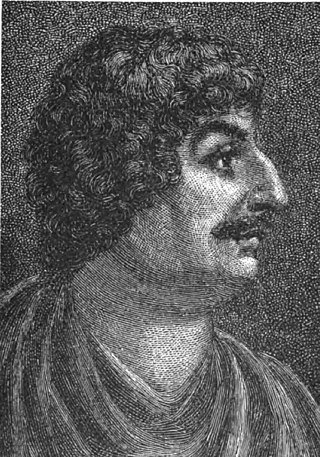
Robert Herrick was a 17th-century English lyric poet and Anglican cleric. He is best known for Hesperides, a book of poems. This includes the carpe diem poem "To the Virgins, to Make Much of Time", with the first line "Gather ye rosebuds while ye may".
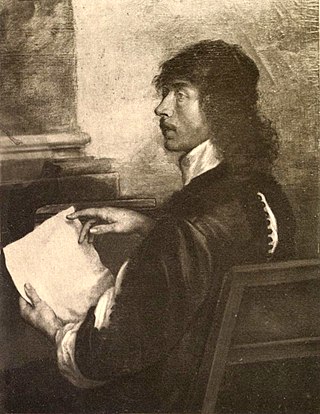
Thomas Carew was an English poet, among the 'Cavalier' group of Caroline poets.
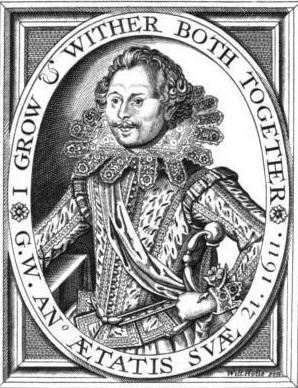
George Wither was a prolific English poet, pamphleteer, satirist and writer of hymns. Wither's long life spanned one of the most tumultuous periods in the history of England, during the reigns of Elizabeth I, James I, and Charles I, the Civil War, the Parliamentary period and the Restoration period.
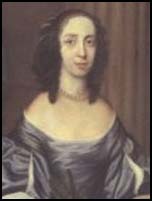
Lucy Hutchinson was an English translator, poet, and biographer, and the first person to translate the complete text of Lucretius's De rerum natura into English verse, during the years of the Interregnum (1649–1660).
John Davy Hayward CBE was an English editor, critic, anthologist and bibliophile.
Thomas May was an English poet, dramatist and historian of the Renaissance era.

Mary Oxlie or Oxley was a 17th-century Scottish or Northumbrian poet, known for one surviving published composition, a "literary eulogy or friendship poem".
Constance Aston Fowler was a 17th-century English manuscript author and anthologist. Born "Constance Aston" about 1621, she was the youngest child of Walter Aston, 1st Lord Aston of Forfar and Gertrude Sadleir, who were a Catholic family. Her home was The Priory at St Thomas, near the family home of Tixal Hall in Staffordshire.

William Strode was an English poet, Doctor of Divinity and Public Orator of Oxford University, one of the Worthies of Devon of John Prince (d.1723).

Cædmon's Hymn is a short Old English poem attributed to Cædmon, a supposedly illiterate and unmusical cow-herder who was, according to the Northumbrian monk Bede, miraculously empowered to sing in honour of God the Creator. The poem is Cædmon's only known composition.
The Great Tew Circle was a group of clerics and literary figures who gathered in the 1630s at the manor house of Great Tew, Oxfordshire in southern England, and in London.
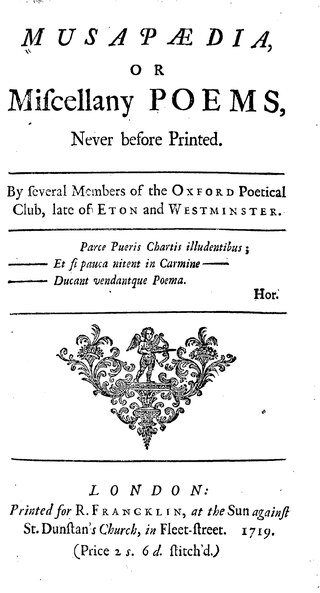
A miscellany is a collection of various pieces of writing by different authors. Meaning a mixture, medley, or assortment, a miscellany can include pieces on many subjects and in a variety of different forms. In contrast to anthologies, whose aim is to give a selective and canonical view of literature, miscellanies were produced for the entertainment of a contemporary audience and so instead emphasise collectiveness and popularity. Laura Mandell and Rita Raley state:
This last distinction is quite often visible in the basic categorical differences between anthologies on the one hand, and all other types of collections on the other, for it is in the one that we read poems of excellence, the "best of English poetry," and it is in the other that we read poems of interest. Out of the differences between a principle of selection and a principle of collection, then, comes a difference in aesthetic value, which is precisely what is at issue in the debates over the "proper" material for inclusion into the canon.

Poetry of Scotland includes all forms of verse written in Brythonic, Latin, Scottish Gaelic, Scots, French, English and Esperanto and any language in which poetry has been written within the boundaries of modern Scotland, or by Scottish people.
Alice Sutcliffe, born Alice Woodhouse or Woodhows, was an English religious writer. Her only known literary work, Meditations of Man's Mortalitie, or, A Way to True Blessednesse, was first published in 1633.

John Dancer was an Irish dramatist, connected with the Theatre Royal, Dublin. His works consist of several translations from Italian and French, original plays, and some miscellaneous stories and poems.
References
- 1 2 Memorials of Cambridge , Macmillan, 1901
- 1 2 3 4 5 6 7 N Postlethwaite, G Campbell, Milton newsletter, Volumes 28-29, Ohio University. Dept. of English 1994, p.83
- ↑ Miscellanea genealogica et heraldica Mitchell and Hughes 1896, p.3
- 1 2 John Ward, The lives of the Professors of Gresham College, 1740, p.281
- ↑ "Paman, Clement (PMN627C)". A Cambridge Alumni Database. University of Cambridge.
- ↑ William White, The Book Collector, Volume 40, The Collector, 1991, P.403
- ↑ Charles Harold Herford, Percy Simpson, Ben Jonson, Volume 11, Clarendon Press 1963, p.485
- ↑ Margo Todd, Christian Humanism and the Puritan Social Order, Cambridge University Press, 2002 p.248
- ↑ Poems of that most neglected Divine Clement Paman D.D., (ed. Ann Sinnett), Foundling Press 2002
- ↑ The Oxford Book of Christian Verse D Cecil (ed.) Clarendon Press 1940
- ↑ Order of Service Archived 2010-11-01 at the Wayback Machine , A Festival of Nine Lessons and Carols King's College Chapel 1999
- ↑ Robert Wilcher, The Writing of Royalism 1628-1660, Cambridge University Press, 2001
- 1 2 Peter Davidson, Poetry and Revolution: An Anthology of British and Irish Verse 1625-1660 Clarendon Press, 1998 lvi
- ↑ The poems of Thomas Carew, Clarendon Press, 1957, p.287